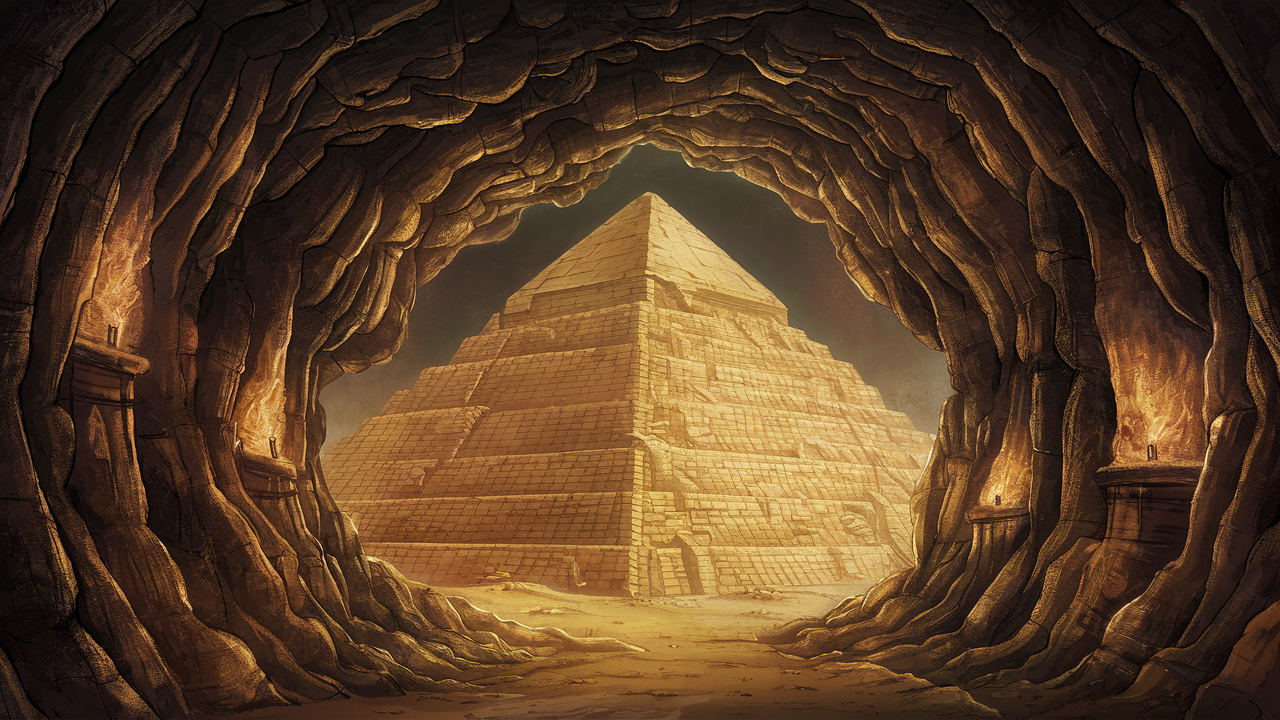Cosmic Rays Shed Light On The Secrets in Hidden Tunnels of the Great Pyramid

Egypt’s Great Pyramid didn’t stop at being the seventh and the only surviving wonder of the world.
It keeps receiving other sub-wonders – secrets that have been hidden beyond its ancient walls for thousands of years.
Talking about a sub-wonder, have you heard about the new discovery?
Scientists just confirmed the latest discovery of a hidden 9-meter (30 feet) tunnel above the main entrance of the Great Pyramid by using cosmic ray muon tomography.
But hold up, ain’t this old news?
Well, not exactly.
Indeed, this new discovery was mentioned in 2017, but this time it’s different. It holds more precise details and fires up curiosity toward muon tomography.
To understand how cosmic rays help in shaping modern archaeology, it’s worth asking two simple questions: what on earth is muon radiography, and how does it work?
Get ready to start off by digging more into its science.
What are muons?
Before delving into muon radiography, let’s take a closer look at the particles themselves and how they’re formed.
Muons are a love child born from a space collision.
To be specific, muons are a byproduct of the collision of high-energy cosmic rays with the earth’s atmosphere.
As a result, this impact creates a shower of secondary particles, including muons.
However, not all particles reach the ground, for not have sufficient mass.
Thanks to their heavy mass and speed close to the speed of light, muons do reach the earth’s surface. (They’re around 200 times heavier than an electron).
On top of that, their ability to go through dense and solid objects with a snap of a finger is fascinating.
Given the amazing characteristics of muons, scientists have come up with a technique called muon tomography that is now in high demand in various fields.
Muon tomography
Muon tomography is a convenient technique used to see through thick and dense materials, such as a pyramid or a mountain.
There’s a rising demand in geology, archaeology, evaluating the damage of nuclear reactors, and planetary science.
So, care to find out how they work? Let’s see.
Now, these muons are sneaky little particles that can penetrate materials that are so dense that even X-rays can’t get through them.
Think of it like taking an X-ray of your body at the doctor’s office, but instead of using X-rays, we’re using these elusive space muons. It’s like having a camera that can penetrate through walls and objects and see that we could never see through before.
What a superpower!
How does muon radiography work in archaeology?
One of the most fascinating applications of muon tomography is in archaeology.
Come closer to unearthing why this technique is such a gem for modern archaeologists.
Given that muon tomography doesn’t involve any intervention, the necessity of digging through ruins or other historical buildings to see what’s inside coming down to zero.
Through images, muons will simply reveal inside structures of objects that are extremely dense to penetrate.
Additionally, damaging ruins and buildings are highly plausible even for the most experienced (not all) archaeologists. Don’t even get me started with enthusiasts just like me or Henrich Schlieman. (The businessman who found, but damaged the ruins of Troy)
So, this method won’t harm any structure.
Hence, the opportunity of discovering more secret tunnels in pyramids, hidden structures, or thousands of other mysteries has never been closer.
With that in mind, let’s now take a closer look at how to conduct muon tomography.
3 steps to conduct muon tomography in archaeology
As it was mentioned above, muon radiography involves detecting muons that penetrate the structure of a particular ancient site. By placing detectors around the site, scientists can measure the number of muons that pass through it from different angles.
Based on these measurements, they can then create a three-dimensional image of the structure of the site, revealing any hidden chambers or structures that might be present. This means that researchers can get a better understanding of how ancient civilizations lived and worked without having to disrupt the site itself.
To conduct muon tomography, archaeologists need to follow a careful and time-consuming process that involves three main steps.
1. Data Collection:
The first step is to collect data using cosmic rays (muons). Scientists place ray detectors at different angles of an object to capture muons passing through it.
2. Image processing:
The collected data is then processed by using special software to create a 3D image of the internal structure.
3. Analysis:
The resulting image can be used to identify hidden chambers and other hidden structures of the scanned object.
This final step requires the knowledge of technical, architectural and cultural context to connect the logical dots. This involves combining the result revealed by muon tomography with the existing knowledge about the researched site.
In the case of the Great pyramid, scientists used muon radiography to discover a hidden 9-meter tunnel above the main entrance. Without this innovative technique, this tunnel may have gone undiscovered for years, potentially hiding important information about the pyramid’s construction and purpose.
Now, however, archaeologists (Kate…) have made suggestions that this tunnel was used to carry the weight of the whole structure.
While the suggestion remains a matter of debate among experts, it however provides a fascinating glimpse into the incredible architectural abilities of our ancient ancestors.
What secret passages have cosmic rays found in Egypt?
To explore the mysteries of ancient Egyptian pyramids, we cannot overlook the groundbreaking Scan Pyramids project and its use of muon tomography and other respective technologies.
Led by the Cairo University and the French Institute of HIP, the Scan Pyramids project was established with the ambitious goal of scanning the Old Kingdom Pyramids to reveal their hidden chambers and structures. In October 2015, the project began its mission, employing an array of non-invasive and non-destructive methods.
Scientists from a variety of countries, including France, Egypt, the UK, and Japan, have contributed to the project, bringing a range of techniques and expertise to the table.
Infrared thermology, 3D simulation, reconstruction, and muon tomography are just some of the innovative methods deployed in the scanning process.
To truly grasp the impact of modern technology on the ancient wonders of Egypt, let us delve deep into the discoveries made possible by these innovative tools and the intriguing hypotheses that have emerged in their wake.
CHRONOLOGY & DISCOVERIES
Their continuous work uncovered new hidden chambers and structures in the Pyramids, helping to gain more insights into the incredible architectural abilities of our ancient ancestors. One of them is still holding secrets of pharaoh Khufu in the Great Pyramid.
Humanity can’t stand secrets and are eager to solve mysteries, which is why Scan Pyramids Project focused their energy on unveiling hidden corridors in the Great Pyramid. Starting from 2016 you’ll see what the team of Egyptian archaeologists and scientists have achieved in 7 years.
2016: Void in the North-Eastern- Edge
As a result of the first scan quest, the Scan Pyramids team were able to discover a roughly 105 m height in the northeast edge of the pyramid.
2016: The second void behind the chevrons
Next the team has confirmed the presence of a cavity behind the chevrons and above the descending corridor of the Great Pyramid. Its shape and size however, have become the subject for further changes.
2017: Reconfirming the characteristics of the void and naming if SP-NFC
Keeping up with the void behind chevrons, this time the team has confirmed the corridor-like shape, as a result of positioning the plates in different points of views. They named this corridor Scan Pyramids North Face Corridor (SP-NFC) and determined its location between 17 and 23 meters from Great Pyramids ground level.
2017: Scan Pyramids Big Void
The sensational Big Void in the Great Pyramid is a tunnel that was discovered just above the Grand Gallery, by using three different muon detection techniques. It has a similar cross section as the Grand Gallery and is about 30 meters long (98 feet). The entrance to the “big void” is blocked by rocks, which makes it physically inaccessible and a matter for its further exploration.
2023: SP-NFC
Following the long-term data collection that started in 2019, researchers shared big news about the size and placement of the void in the North Face Corridor. Overall, the length of the tunnel is approximately 30 feet long, 7 feet tall, and 7 feet wide.
Purpose of the Tunnel SP-NFC Tunnel:
The purpose of the mysterious void inside the Great Pyramid of Giza is subject to varying interpretations. One hypothesis suggests that it could be a secret burial chamber of the pharaoh Khufu, who commissioned the pyramid’s construction some 4,500 years ago. The other hypothesis, put forth by archaeologists, challenges the notion of any ritual significance and posits that the gaps in the pyramid’s structure were built to relieve pressure and maintain structural stability. As noted by both Kate Spence and Mark Lehner, researchers have found evidence to support this second theory.
Despite using modern devices to reveal precise measurements of the tunnel, it is still exciting that some puzzles are waiting for us to be solved.
